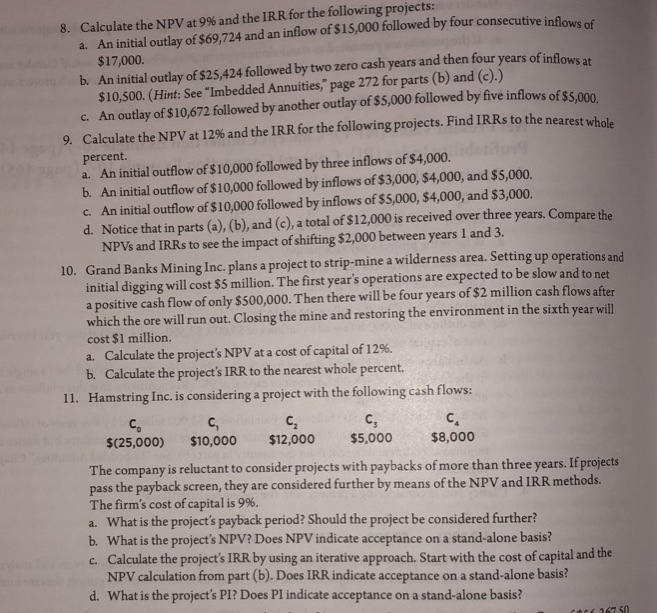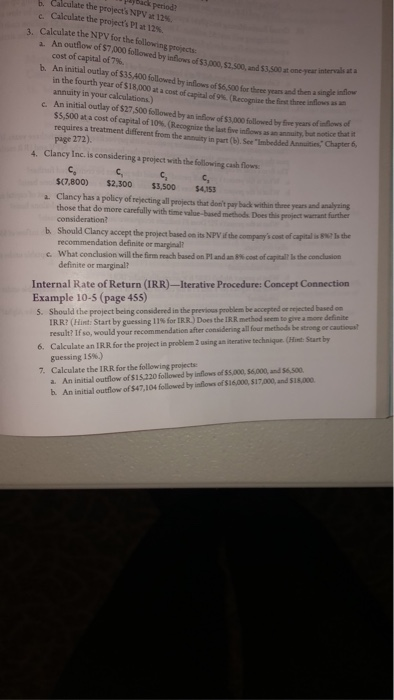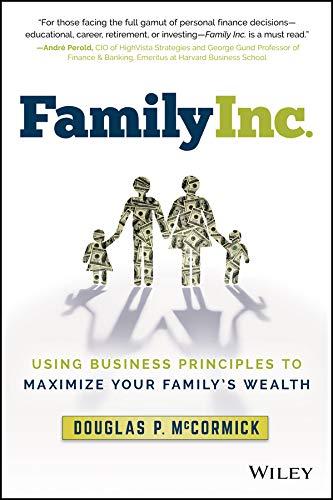5 through 11 (ASAP) with formulas

Internal Rate of Return (IRR)Iterative Procedure: Concept Connection Example 10-5 (page 455) 5. Should the project being considered in the previous problem be accepted or rejected based on IRR? (Hint: Start by guessing 11% for IRR.) Does the IRR method seem to give a more definite result? If so, would your recommendation after considering all four methods be strong or cautious? 6. Calculate an IRR for the project in problem 2 using an iterative technique. (Hint: Start by guessing 159.) 7. Calculate the IRR for the following projects: a. An initial outflow of $15,220 followed by inflows of $5,000, S6,000, and $6,500. b. An initial outflow of $47,104 followed by inflows of $16,000, $17,000, and $18,000. 8. Calculate the NPV at 9% and the IRR for the following projects: a. An initial outlay of $69.724 and an inflow of $15,000 followed by four consecutive inflour $17,000 b. An initial outlay of $25,424 followed by two zero cash years and then four years of inflows $10,500. (Hint: See "Imbedded Annuities," page 272 for parts (b) and (c).) c. An outlay of $10,672 followed by another outlay of $5,000 followed by five inflows of $5.000 9. Calculate the NPV at 12% and the IRR for the following projects. Find IRRs to the nearest what percent. a. An initial outflow of $10,000 followed by three inflows of $4,000. b. An initial outflow of $10,000 followed by inflows of $3,000, $4,000, and $5,000. c. An initial outflow of $10,000 followed by inflows of $5,000, $4,000, and $3,000. d. Notice that in parts (a), (b), and (c), a total of $12,000 is received over three years. Compare the NPVs and IRRs to see the impact of shifting $2,000 between years 1 and 3. 10. Grand Banks Mining Inc. plans a project to strip-mine a wilderness area. Setting up operations and initial digging will cost $5 million. The first year's operations are expected to be slow and to net a positive cash flow of only $500,000. Then there will be four years of $2 million cash flows after which the ore will run out. Closing the mine and restoring the environment in the sixth year will cost $1 million. a. Calculate the project's NPV at a cost of capital of 12%. b. Calculate the project's IRR to the nearest whole percent. 11. Hamstring Inc. is considering a project with the following cash flows: co con cccc. $(25,000) $10,000 $12,000 $5,000 $8,000 The company is reluctant to consider projects with paybacks of more than three years. If projects pass the payback screen, they are considered further by means of the NPV and IRR methods. The firm's cost of capital is 9%. a. What is the project's payback period? Should the project be considered further? b. What is the project's NPV? Does NPV indicate acceptance on a stand-alone basis? c. Calculate the project's IRR by using an iterative approach. Start with the cost of capital and the NPV calculation from part (b). Does IRR indicate acceptance on a stand-alone basis? d. What is the project's PI? Does PI indicate acceptance on a stand-alone basis? cere 26750 back periode b. Calculate the project's NPV 124 c. Calculate the project's Plz 12 Calculate the NPV for the following process . An outlow of 57,000 followed by lowest 525 d 3.500 at one year inte cost of capital of 7% b. An initial outiny of $35.400 followed by t h e sand then an in the fourth year of $18,000 at a cost of the flow annuity in your calculations.) An initial outlay of $27,500 followed by an inbow of S ol f eyears of towe s anity, but notice that $5,500 at a cost of capital of 10%. (Recognize the last five in requires a treatment different from the twin (Semedord Annuities," Chapter for three years and then a single inflow page 272) 4. Clancy Inc. is considering a project with the following cash flow $07,800) $2,300 5 3,500 $4,153 a. Clancy has a policy of rejecting all projects that don't pay back within the years and analysing those that do more carefully with time value-based methods Does this project warrant further consideration? b. Should Clancy accept the project based on its NPV if the company's cost of capital i s the recommendation definite or marginal c. What conclusion will the firm reach based on and an 8 cost of a ll is the conclusion definite ar marginal? Internal Rate of Return (IRR)-Iterative Procedure: Concept Connection Example 10-5 (page 455) 5. Should the project being considered in the previous problem be accepted or rejected based on IRR? (Hint: Start by guessing 11% for IRR) Does the IRR method seem to give a more definite result? If so, would your recommendation after considering all four methods be strong or caus! 6. Calculate an IRR for the project in problem 2 using an iterative technique. (Host: Start by guessing 15%) 7. Calculate the IRR for the following projects a. An initial outflow of $15.220 followed by inflows of 5,000, 56,000, and 56 500 h. An initial outflow of $47,104 followed by inflows of 16,000, 517,000, and $15.000










